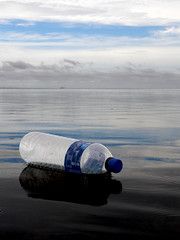Perils of plastics: Risks to human health and the environment

While plastics have legitimate uses of benefit to society, their brazen misuse has led to a radically unsustainable condition.
Now Rolf Halden, associate professor in the School of Sustainable Engineering at Arizona State University and assistant director of Environmental Biotechnology at the Biodesign Institute has undertaken a survey of existing scientific literature concerning the hazards of plastics to human health and to the ecosystems we depend on.
Today, plastics accumulate in garbage dumps and landfills and are sullying the world's oceans in ever-greater quantity. And plastics and their additives aren't just around us, they are inside virtually every one of us- present in our blood and urine in measureable amounts, ingested with the food we eat, the water we drink and from other sources.
Two broad classes of plastic-related chemicals are of critical concern for human health-bisphenol-A or BPA, and additives used in the synthesis of plastics, which are known as phthalates.
BPA is a basic building block of polycarbonate plastics, such as those used for bottled water, food packaging and other items. While it has been considered benign in the form of a heavily cross-linked polymer, its bonds can break down over time, when plastics are repeatedly washed, exposed to heat or other stresses, liberating the building blocks of the chemical, which are toxic. BPA has been recognized since the 1940s as an endocrine disrupting chemical that interferes with normal hormonal function.
Adding to the health risks associated with BPA is the fact that other ingredients-such as plasticizers-are commonly added to plastics. Many of these potentially toxic components also can leach out over time. Among the most common is a chemical known as di-ethylhexyl phthalate or DEHP. In some products, notably medical devices including IV bags or tubing, additives like DEHP can make up 40 or 50 percent of the product. If you're in a hospital, hooked up to an IV drip, Halden explains, the chemical that oozes out goes directly into your bloodstream, with no opportunity for detoxification in the gut. This can lead to unhealthy exposure levels, particularly in susceptible populations such as newborns.
Halden points out that the difficulty lies in the absence of good controls for studying health outcomes, as plastic exposure is a global phenomenon, and finding unexposed subjects for comparison is nearly impossible.
This January, the FDA announced an important reversal of its 2008 claims regarding the safety of bisphenol-A, expressing new concern about potential effects of BPA on the brain, behavior and prostate gland of fetuses, infants and children, and pledging to collaborate with other federal health agencies to reevaluate the chemical's safety.
We are at a critical juncture, Halden warns, and cannot continue under the modus that has been established. If we're smart, we'll look for replacement materials, so that we don't have this mismatch-good for a minute and contaminating for 10,000 years.





















